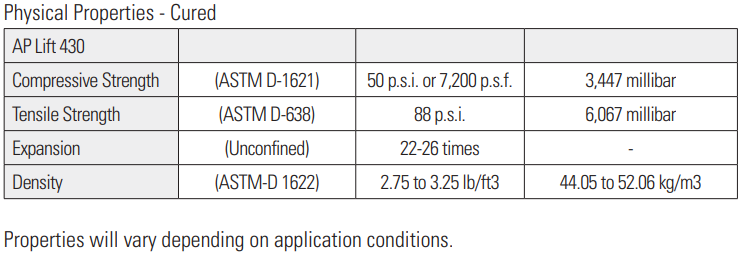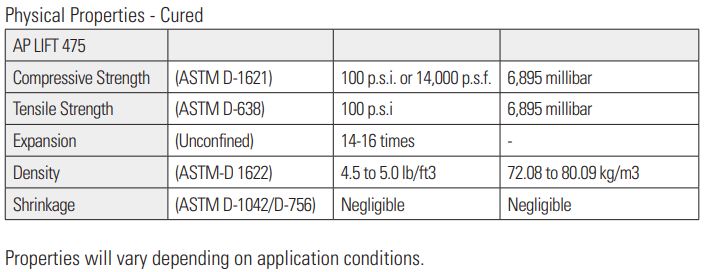
 Foundation foam is a trusted solution for engineers and contractors addressing soil stabilization and structural support challenges. This proven technology effectively tackles issues caused by unstable soil, from erosion to poor compaction. Over the years, it has established itself as an essential tool for maintaining the integrity of buildings, roads, and other infrastructure.
Foundation foam is a trusted solution for engineers and contractors addressing soil stabilization and structural support challenges. This proven technology effectively tackles issues caused by unstable soil, from erosion to poor compaction. Over the years, it has established itself as an essential tool for maintaining the integrity of buildings, roads, and other infrastructure.
Why Soil Stability Matters
Unstable soil poses significant risks to structures built upon it. For instance, erosion, poor compaction, and freeze-thaw cycles can lead to settling, cracking, and even catastrophic failure. Moreover, these issues often occur deep beneath the surface, making them difficult to address using traditional methods. Therefore, reliable solutions are crucial for ensuring long-term structural integrity.
The Power of Foundation Foam
Foundation foam offers a dependable solution to these challenges. Unlike conventional methods, it can be injected deep into the soil without heavy excavation equipment, allowing for precise soil stabilization and compaction. Furthermore, the foam cures quickly. This rapid curing time significantly reduces project downtime and improves overall efficiency.
One-Component Standard Soil Stabilization
One-component foundation foam products offer durable and effective solutions for standard soil stabilization projects. These products are perfect for soil permeation, spreading through, and strengthening loose or unstable soil.
Their ability to permeate soil makes them excellent choices for addressing issues like erosion, poor compaction, and water infiltration. As a result, these one-component foundation foam solutions can effectively stabilize soil without requiring extensive excavation or heavy machinery.
Two-Component Deep Lock® Stabilization
The Deep Lock® process utilizes two-component foundation foam products for deep soil issues. These include:
The Deep Lock® process allows for soil stabilization at greater depths, thus making it particularly useful for large-scale projects or structures with significant foundation issues. Additionally, this method can achieve soil stabilization and compaction with minimal surface disruption.
Versatility in Application
One of the critical advantages of foundation foam is its versatility. It can be used in a variety of scenarios, including:
- Supporting settled buildings
- Enhancing soil density around pipes and tunnels
- Reinforcing bridge approach slabs
- Strengthening port and airport infrastructure
Foundation foam provides long-lasting support and protection against future settling or erosion in each application. Consequently, it has become a go-to solution for many construction and rehabilitation projects.
Comparing Foundation Foam to Traditional Methods
Compared to traditional soil stabilization methods, foundation foam stands out in several ways. For example, cement pressure grouting requires heavy equipment and can be messy and imprecise. Similarly, helical piers and push piers, while effective, are often more invasive and limited in their application.
In contrast, foundation foam is less invasive, faster to install, and addresses underlying soil issues more comprehensively. Moreover, it can be combined with other methods for even more effective results. Therefore, it offers a more flexible and efficient solution for many soil stabilization projects.
Environmental Considerations
An important aspect of foundation foam is its environmental safety. Alchatek foundation foams are NSF-certified to strict ecological standards. This certification ensures that the cured foam won't negatively impact groundwater quality. As a result, these foundation foams are a responsible choice for projects in environmentally sensitive areas. This rigorous environmental compliance further enhances their appeal as a trusted soil stabilization solution.
Long-Term Benefits
The long-term benefits of foundation foam are substantial. Once cured, the foam creates a stable, water-resistant barrier lasting decades. This longevity translates to reduced maintenance costs and improved structural integrity over time. As a result, property owners can enjoy peace of mind knowing their investments are protected for years to come.
A Solid Foundation for the Future
Consistently providing an effective solution to soil issues, foundation foam has proven instrumental in ensuring the longevity and safety of buildings and infrastructure worldwide. With its track record of success, foundation foam continues to be a go-to choice for construction and rehabilitation projects of all sizes. This time-tested technology remains at the forefront of creating stable and resilient structures for the present and future.
Want more information on stabilizing soil with foundation foam?


 Mid South Concrete Lifting successfully executed an emergency repair operation at a Tennessee Valley Authority (TVA) lift station in New Johnsonville, Tennessee. What began as a new construction project quickly required an urgent repair when significant leakage was discovered at multiple joint locations immediately after installation. The contractor's rapid response and innovative solution prevented extensive water loss and potential environmental impacts.
Mid South Concrete Lifting successfully executed an emergency repair operation at a Tennessee Valley Authority (TVA) lift station in New Johnsonville, Tennessee. What began as a new construction project quickly required an urgent repair when significant leakage was discovered at multiple joint locations immediately after installation. The contractor's rapid response and innovative solution prevented extensive water loss and potential environmental impacts.


 Essential Details
Essential Details

 A concrete staircase in a prominent mixed-use complex in Atlanta needed urgent repairs due to a set of 75-foot-long sunken steps. This issue posed a significant trip hazard, potentially compromising visitor safety. The problem stemmed from a combination of factors working together over time. Water infiltration through expansion cracks had created voids beneath the stairs, weakening their foundation. Compounding this issue was the natural tendency of separate concrete pieces to expand and contract, moving independently. This movement was particularly problematic as it caused the steps to separate from the adjacent sidewalk. Over time, the repeated cycles of expansion and contraction, coupled with the underlying voids, led to the steps sinking and rolling, creating a hazardous situation.
A concrete staircase in a prominent mixed-use complex in Atlanta needed urgent repairs due to a set of 75-foot-long sunken steps. This issue posed a significant trip hazard, potentially compromising visitor safety. The problem stemmed from a combination of factors working together over time. Water infiltration through expansion cracks had created voids beneath the stairs, weakening their foundation. Compounding this issue was the natural tendency of separate concrete pieces to expand and contract, moving independently. This movement was particularly problematic as it caused the steps to separate from the adjacent sidewalk. Over time, the repeated cycles of expansion and contraction, coupled with the underlying voids, led to the steps sinking and rolling, creating a hazardous situation.


 Essential Details
Essential Details
 Foundation foam is a trusted solution for engineers and contractors addressing soil stabilization and structural support challenges. This proven technology effectively tackles issues caused by unstable soil, from erosion to poor compaction. Over the years, it has established itself as an essential tool for maintaining the integrity of buildings, roads, and other infrastructure.
Foundation foam is a trusted solution for engineers and contractors addressing soil stabilization and structural support challenges. This proven technology effectively tackles issues caused by unstable soil, from erosion to poor compaction. Over the years, it has established itself as an essential tool for maintaining the integrity of buildings, roads, and other infrastructure.

 Water leaks in concrete slabs can be a severe issue for property owners. These leaks occur when water from the ground seeps through cracks or gaps in the concrete foundation, leading to moisture problems inside the building. If not addressed promptly, these upward-moving leaks can lead to structural issues, damage flooring materials, and create an environment conducive to unhealthy mold growth. Curtain grouting with polyurethane is a proven technique for effectively fixing water leaks in concrete slabs. This method creates a barrier beneath the slab, preventing water from penetrating upwards and resolving the issue at its source.
Water leaks in concrete slabs can be a severe issue for property owners. These leaks occur when water from the ground seeps through cracks or gaps in the concrete foundation, leading to moisture problems inside the building. If not addressed promptly, these upward-moving leaks can lead to structural issues, damage flooring materials, and create an environment conducive to unhealthy mold growth. Curtain grouting with polyurethane is a proven technique for effectively fixing water leaks in concrete slabs. This method creates a barrier beneath the slab, preventing water from penetrating upwards and resolving the issue at its source.

 A critical infrastructure issue emerged on a four-lane road near downtown San Francisco. Soil erosion caused a bridge approach slab to settle 2.5 to 3 inches over time. The affected area had an asphalt surface with a thin sleeper slab underneath. California Department of Transportation (Caltrans) engineers initially advocated for complete replacement. The situation changed when
A critical infrastructure issue emerged on a four-lane road near downtown San Francisco. Soil erosion caused a bridge approach slab to settle 2.5 to 3 inches over time. The affected area had an asphalt surface with a thin sleeper slab underneath. California Department of Transportation (Caltrans) engineers initially advocated for complete replacement. The situation changed when 


 Polyurethane slab lifting effectively restores sunken concrete surfaces. This process relies on specialized
Polyurethane slab lifting effectively restores sunken concrete surfaces. This process relies on specialized 

 Essential Details
Essential Details